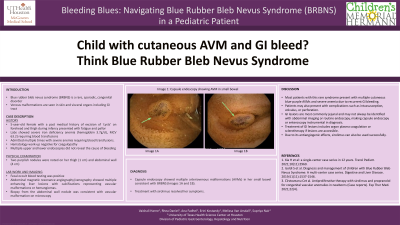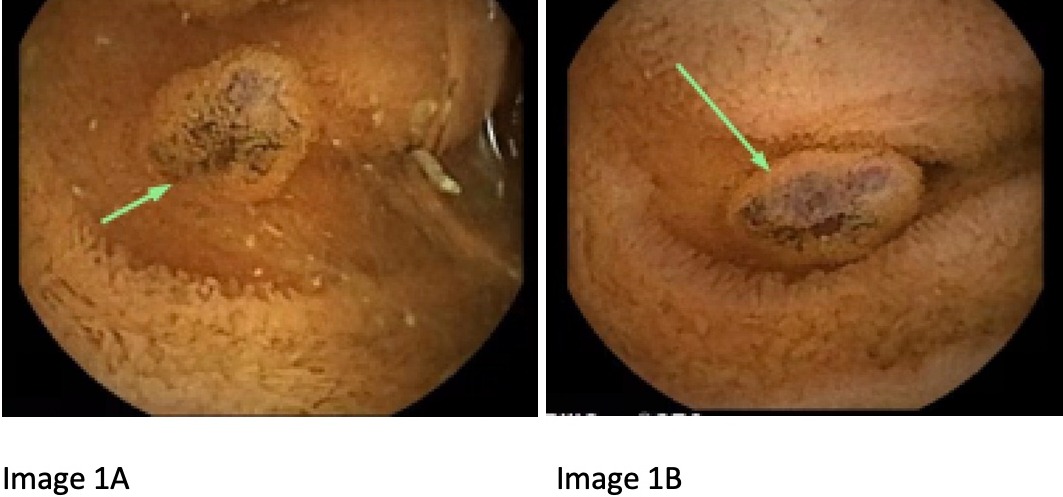Sunday Poster Session
Category: Pediatrics
P1191 - Bleeding Blues: Navigating Blue Rubber Bleb Nevus Syndrome (BRBNS) in a Pediatric Patient
Sunday, October 22, 2023
3:30 PM - 7:00 PM PT
Location: Exhibit Hall

Has Audio

Vaishali Harne, MD
University of Texas Health Science Center at Houston
Houston, TX
Presenting Author(s)
Vaishali Harne, MD, Rhea Daniel, MD, Ana Fadhel, MD, Erini Kostandy, MD, Melissa Van Arsdall, MD, Supriya Nair, MD
University of Texas Health Science Center at Houston, Houston, TX
Introduction: Blue rubber bleb nevus syndrome (BRBNS) is a rare, sporadic, congenital disorder of venous malformations in the skin and visceral organs including the gastrointestinal (GI) tract with only about 350 cases reported world-wide. We present the case of a young child found to have this rare syndrome after presenting with severe anemia due to GI bleeding.
Case Description/Methods: A 5-year-old female with a past medical history significant for excision of ‘cysts’ on her forehead and thigh during infancy presented to the hospital with fatigue and pallor. She was diagnosed with severe iron deficiency anemia (hemoglobin 3.7g/dL, MCV 63.2) requiring blood transfusions and iron supplementation. She was admitted twice over the next two years with severe anemia requiring blood transfusions. Hematology work-up was negative for coagulopathy. Physical examination revealed two purplish nodules on her thigh (1 cm) and abdominal wall (4 cm). She was empirically treated with antibiotics twice for Helicobacter pylori infection without resolution of her anemia. Fecal occult blood testing was positive; however, multiple upper and lower endoscopies did not reveal the cause of bleeding. Abdominal magnetic resonance angiography/venography showed multiple enhancing liver lesions with calcifications representing vascular malformations or hemangiomas. A biopsy from the abdominal wall nodule described as “tan-gray rubbery soft tissue” was consistent with a vascular malformation on microscopy. The cause of her severe anemia was identified with capsule endoscopy showing multiple arteriovenous malformations (AVMs) in her small bowel consistent with BRBNS (Images 1A and 1B). Treatment was initiated with sirolimus, which resolved symptoms.
Discussion: Most patients with this rare syndrome present with multiple cutaneous blue-purple AVMs and severe anemia due to recurrent GI bleeding. Patients may also present with complications such as intussusception, volvulus, or perforation. GI lesions are most commonly jejunal and may not always be identified with abdominal imaging or routine endoscopy, making capsule endoscopy or enteroscopy instrumental in diagnosis. Though this is a rare condition, physicians should have a high index of suspicion for this syndrome in young patients presenting with anemia and cutaneous AVMs. Treatment of GI lesions includes argon plasma coagulation or sclerotherapy if lesions are accessible. Due to its antiangiogenic effects, sirolimus can also be used successfully, as in the case of our patient.

Disclosures:
Vaishali Harne, MD, Rhea Daniel, MD, Ana Fadhel, MD, Erini Kostandy, MD, Melissa Van Arsdall, MD, Supriya Nair, MD. P1191 - Bleeding Blues: Navigating Blue Rubber Bleb Nevus Syndrome (BRBNS) in a Pediatric Patient, ACG 2023 Annual Scientific Meeting Abstracts. Vancouver, BC, Canada: American College of Gastroenterology.
University of Texas Health Science Center at Houston, Houston, TX
Introduction: Blue rubber bleb nevus syndrome (BRBNS) is a rare, sporadic, congenital disorder of venous malformations in the skin and visceral organs including the gastrointestinal (GI) tract with only about 350 cases reported world-wide. We present the case of a young child found to have this rare syndrome after presenting with severe anemia due to GI bleeding.
Case Description/Methods: A 5-year-old female with a past medical history significant for excision of ‘cysts’ on her forehead and thigh during infancy presented to the hospital with fatigue and pallor. She was diagnosed with severe iron deficiency anemia (hemoglobin 3.7g/dL, MCV 63.2) requiring blood transfusions and iron supplementation. She was admitted twice over the next two years with severe anemia requiring blood transfusions. Hematology work-up was negative for coagulopathy. Physical examination revealed two purplish nodules on her thigh (1 cm) and abdominal wall (4 cm). She was empirically treated with antibiotics twice for Helicobacter pylori infection without resolution of her anemia. Fecal occult blood testing was positive; however, multiple upper and lower endoscopies did not reveal the cause of bleeding. Abdominal magnetic resonance angiography/venography showed multiple enhancing liver lesions with calcifications representing vascular malformations or hemangiomas. A biopsy from the abdominal wall nodule described as “tan-gray rubbery soft tissue” was consistent with a vascular malformation on microscopy. The cause of her severe anemia was identified with capsule endoscopy showing multiple arteriovenous malformations (AVMs) in her small bowel consistent with BRBNS (Images 1A and 1B). Treatment was initiated with sirolimus, which resolved symptoms.
Discussion: Most patients with this rare syndrome present with multiple cutaneous blue-purple AVMs and severe anemia due to recurrent GI bleeding. Patients may also present with complications such as intussusception, volvulus, or perforation. GI lesions are most commonly jejunal and may not always be identified with abdominal imaging or routine endoscopy, making capsule endoscopy or enteroscopy instrumental in diagnosis. Though this is a rare condition, physicians should have a high index of suspicion for this syndrome in young patients presenting with anemia and cutaneous AVMs. Treatment of GI lesions includes argon plasma coagulation or sclerotherapy if lesions are accessible. Due to its antiangiogenic effects, sirolimus can also be used successfully, as in the case of our patient.

Figure: Image 1 A and B: Capsule endoscopy showing AVM in small bowel
Disclosures:
Vaishali Harne indicated no relevant financial relationships.
Rhea Daniel indicated no relevant financial relationships.
Ana Fadhel indicated no relevant financial relationships.
Erini Kostandy indicated no relevant financial relationships.
Melissa Van Arsdall: QOL Medical, LLC – Site PI for multi-center trial investigating children's symptom response to Sucraid; the university is reimbursed for study visits I conduct.
Supriya Nair: Amarin – Stock-publicly held company(excluding mutual/index funds). Editas – Stock-publicly held company(excluding mutual/index funds). Exelixis – Stock-publicly held company(excluding mutual/index funds). Moderna – Stock-publicly held company(excluding mutual/index funds). Pfizer – Stock-publicly held company(excluding mutual/index funds). Repligen – Stock-publicly held company(excluding mutual/index funds). Syros – Stock-publicly held company(excluding mutual/index funds). Tandem – Stock-publicly held company(excluding mutual/index funds). Viatris – Stock-publicly held company(excluding mutual/index funds).
Vaishali Harne, MD, Rhea Daniel, MD, Ana Fadhel, MD, Erini Kostandy, MD, Melissa Van Arsdall, MD, Supriya Nair, MD. P1191 - Bleeding Blues: Navigating Blue Rubber Bleb Nevus Syndrome (BRBNS) in a Pediatric Patient, ACG 2023 Annual Scientific Meeting Abstracts. Vancouver, BC, Canada: American College of Gastroenterology.
